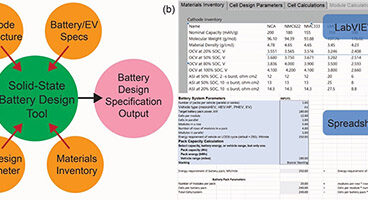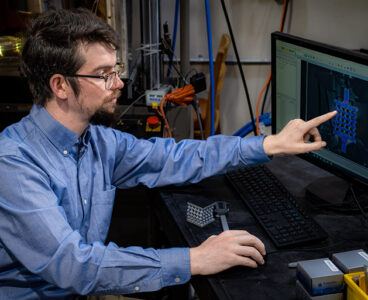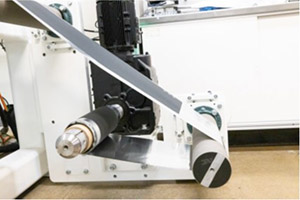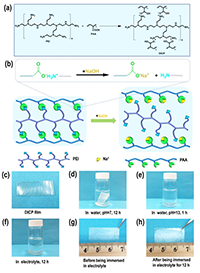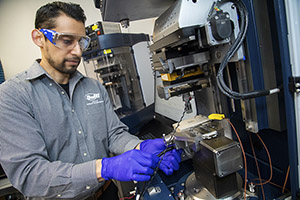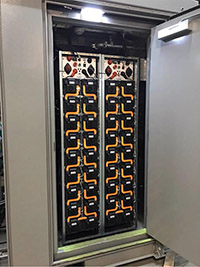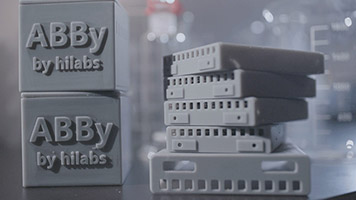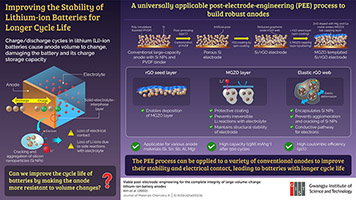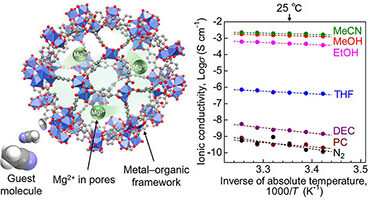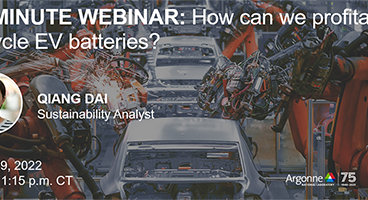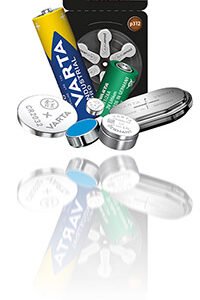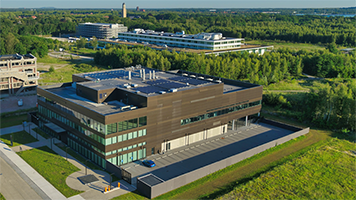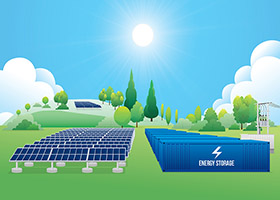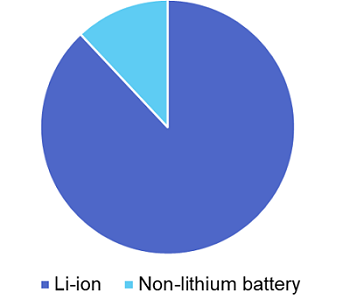From Chiba University Fuel cells, while promising, are expensive due to high catalyst requirements to increase the oxygen reduction reaction (ORR) activity. In a breakthrough, researchers found that adding caffeine to the electrodes can improve the ORR activity of platinum electrodes 11 times. This discovery can enhance the efficiency of the fuel cell, reduce the…
Incheon National University researchers enhance the safety of lithium batteries
From Incheon National University: Lithium-ion batteries face safety concerns due to internal separator issues that often lead to short circuits. Scientists have now developed a method to improve the stability and properties of separators with a layer of silicon dioxide and other functional molecules. Batteries employing these separators demonstrated improved performance and reduced growth of…
R&D 100 winner of the day: SolidPAC: A Comprehensive Solid-State Battery Design Tool
Oak Ridge National Laboratory’s Solid-state batteries (SSBs) have the potential to be significant next-generation technologies for high-energy and high-power-density rechargeable battery applications. It is crucial to identify the metrics that an emerging battery technology should fulfill to achieve parity with conventional lithium-ion batteries, primarily in terms of energy density. However, limited approaches exist today to…
Research at VW’s Innovation Hub drives advances in EV range, recycled vehicle materials
Volkswagen Group of America, Inc. is boosting its automotive research in the United States to further accelerate electric mobility and sustainable transportation innovation. The company continues to center strategic areas of research in dedicated technology units across the country, as well as foster co-innovation with universities and federal research facilities. One key unit is in…
R&D 100 winner of the day: RapidCure: High-Speed Electron Beam Processing of Battery Electrodesc
Oak Ridge National Laboratory’s High-Speed Electron Beam Processing is a low-cost, environmentally benign, and low-carbon-footprint process for producing thick Li-ion battery electrodes. This novel manufacturing approach eliminates the use of the solvent, a toxic volatile organic compound, and the high-molecular-weight material used in the traditional PVFD/NMP manufacturing method. The NMP solvent is expensive and toxic…
Bostik and Polytec PT launch new TCA range to spur innovation in battery design
Bostik and Polytec PT have collarborated to launch a new range of thermal conductive adhesives (TCA) to address the challenge of thermal management in the latest Cell-to-Pack (CTP) battery design for e-mobility solutions. Thermal management is vital to ensuring the operating temperature of EV-battery systems remains between 20° C and 40° C for optimum battery…
R&D 100 winner of the day: Expanded Cellulose Super Ion Conductor
In pursuit of high-energy and safe batteries, researchers are working to replace the common liquid electrolytes with solid ion conductors. Solid polymer electrolytes are promising candidates but often have limited ionic conductivities of < 10-5 S/cm. This conductivity dilemma has persisted since the solid polymer electrolyte concept was proposed in 1978. The team at the…
R&D 100 winner of the day: Electrochemical Leach (EC-Leach)
Idaho National Laboratory’s EC-Leach provides a cost-effective, highly efficient, safe, and carbon-free process for solving one of the world’s biggest clean energy challenges: lithium-ion battery recycling. The electrochemical approach provides flexible capacity capabilities that allow it to be used in centralized operational facilities as well as distributed facilities at the point of disposal. It provides…
R&D 100 winner of the day: Safety & Reliability with Silicone Solutions for Electric Vehicle Thermal Management
Elkem Silicones developed a new syntactic silicone foam that provides reliable thermal and electrical insulation in electric vehicle (EV) batteries. This low-density, room-temperature curing foam protects battery cells against propagation and thermal runaway to other cells, and thermal stability to protect against harsh chemical environments. Safety and reliability are critical parameters when designing EV battery…
R&D 100 winner of the day: Quick-Release Binder for Recyclable Batteries
The Quick-Release Binder, from Lawrence Berkeley National Laboratory and Co-developer OnTo Technology, is a fully reversible binder for Li-ion batteries, allowing quick cathode and anode material recovery in aqueous media, for direct recycling. This binder is made of two commercially available low-cost chemicals: polyacrylic acid (PAA) and polyethyleneimine (PEI). Both chemicals can also be recycled…
Zinc Battery Initiative welcomes developer of novel battery-enhancing additive
Zinc Battery Initiative (ZBI), the voice of the zinc battery industry, welcomes new member Octet Scientific Inc., a developer of innovative electrolyte additives to improve battery performance. ZBI’s rapidly growing membership is comprised of leading zinc battery manufacturers as well as developers of products designed to enhance battery capability. Located in Cleveland, Octet Scientific has…
Southwest Research Institute develops device to test friction, wear associated with EV fluids
From Southwest Research Institute A Southwest Research Institute team has developed a mechanical testing device to analyze fluids and lubricants formulated for electric vehicles. The team modified a commercial tribology testing device to give it the capability to evaluate the impact of electric currents in fluids, measuring the wear and friction on the automobile parts…
Halo Microelectronics introduces a new Li-Ion and Li-Pol battery charger with auto start
Halo Microelectronics, a maker of analog and power management integrated circuits enabling energy-efficient smart systems, announces the release of its HL7040C, a highly integrated family of 2×2 mm single-cell Li-Ion and Li-Pol linear charger. The HL7040C is suitable for portable applications, including smartphones, PDAs, MP3 players, and low-powered handheld devices with limited board space, as…
N.Y. agencies announce new energy storage technology to benefit public power
The New York Power Authority (NYPA) and the New York State Energy Research and Development Authority (NYSERDA) announced that a first-of-its-kind battery energy storage system (BESS) using patented, high-safety, lithium-ion (Li-ion) superCell technology is delivering energy peak shaving capabilities to NYPA’s White Plains offices, as part of a demonstration project. The BESS developed by Cadenza…
Rinse and repeat: An easy new way to recycle batteries is here
By Aliyah Kovner, Berkeley National Laboratory Lithium-ion batteries have revolutionized electronics and enabled an accelerating shift toward clean energy. These batteries have become an integral part of 21st century life, but we’re at risk of running out before 2050. The main elements used in each battery – lithium, nickel, and cobalt metals as well as…
Zinc battery initiative expands with innovative German battery developer HILABS
Zinc Battery Initiative (ZBI), the voice of the zinc battery industry, announces plans to welcome German battery developer HILABS. ZBI’s rapidly growing membership is comprised of leading zinc battery manufacturers, including HILABS, which has developed a scalable, safe, and affordable zinc-air battery designed as an alternative to lead-acid, and lithium-ion batteries in a variety of…
Better batteries for a better future
By Erin Matthews, The Canadian Light Source (CLS), University of Saskatchewan The international group of experts, led by researchers from Texas A&M University, have combined powerful imaging techniques and large data sets to better understand why lithium-ion batteries fail and how they can be improved. Their innovative approach has brought the team one step closer…
GIST Scientists develop a universal method for improving the lifespan of li-ion batteries
Charging and discharging a lithium-ion battery multiple times causes significant change to the volume of the anode, reducing the battery capacity and battery life. Now researchers from GIST in Korea have developed a method to strengthen the anode, making it more resilient against volume changes. The anode can be modified irrespective of its material…
New magnesium superionic conductor towards lithium-free solid-state batteries
As we move towards a more energy-efficient society, the need for high-capacity, cost-effective batteries is greater than ever. Magnesium is a promising material for such solid-state batteries owing to its abundance, but its practical application is limited by the poor conductivity of magnesium ions (Mg2+) in solids at room temperature. Recently, researchers from Japan have…
These energy-packed batteries work well in extreme cold and heat
by University of California San Diego Engineers at the University of California San Diego have developed lithium-ion batteries that perform well at freezing cold and scorching hot temperatures, while packing a lot of energy. The researchers accomplished this feat by developing an electrolyte that is not only versatile and robust throughout a wide temperature range,…
Argonne webinar to explore the challenges of recycling lithium-ion batteries and solutions
Auto makers are racing to produce electric vehicles, but few firms know how to recycle old EV batteries. A scientist at Argonne National Laboratory is hosting a 15-minute webinar on June 29 at 1 p.m. CT that will describe the path businesses can take to recycle those batteries profitably. In 2020, over 1.7 million electric…
VARTA presents microbattery product portfolio at COMPUTEX 2022
VARTA will present its broad product portfolio of microbatteries, which make a wide range of future-proof applications possible, at COMPUTEX in Taipei, which takes place May 24-27. VARTA’s microbattery product portfolio ranges from rechargeable lithium-ion button cells to nickel metal hydride button cells, primary silver oxide cells, primary lithium button cells and cylindrical lithium batteries…
SOLiTHOR seeds $10.6M to develop a new solid-state battery cell technology
SOLiTHOR, the newly created spin-off company from imec – partner in the European energy R&D innovation hub Energyville – is spearheading the development, manufacturing and commercialization of innovative solid-state lithium (Li) battery cell technology to reliably and economically offer high energy storage solutions. SOLiTHOR raised $10.6 million (€10 million) in a seed investment round led…
Growing zinc battery initiative welcomes startup Zēlos Energy
Silicon Valley startup Zēlos Energy announces plans to join the Zinc Battery Initiative (ZBI), the voice of the zinc battery industry. ZBI’s rapidly growing membership is comprised of leading zinc battery manufacturers, including Zēlos, which has developed a sustainable, safe zinc-manganese battery designed as an alternative to lead acid and lithium-ion batteries in a variety…
Alternatives to lithium-based batteries to play a key role for stationary storage, says IDTechEx
Announcements of developments to alternative, next-generation, non-lithium battery chemistries, including redox flow, metal-air, or sodium-ion batteries, are now a regular occurrence. Despite interest in these alternatives, Li-ion batteries remain the dominant choice for consumer devices, electric vehicles, and stationary storage. However, the importance of non-lithium battery chemistries is expected to grow considerably over the next…



